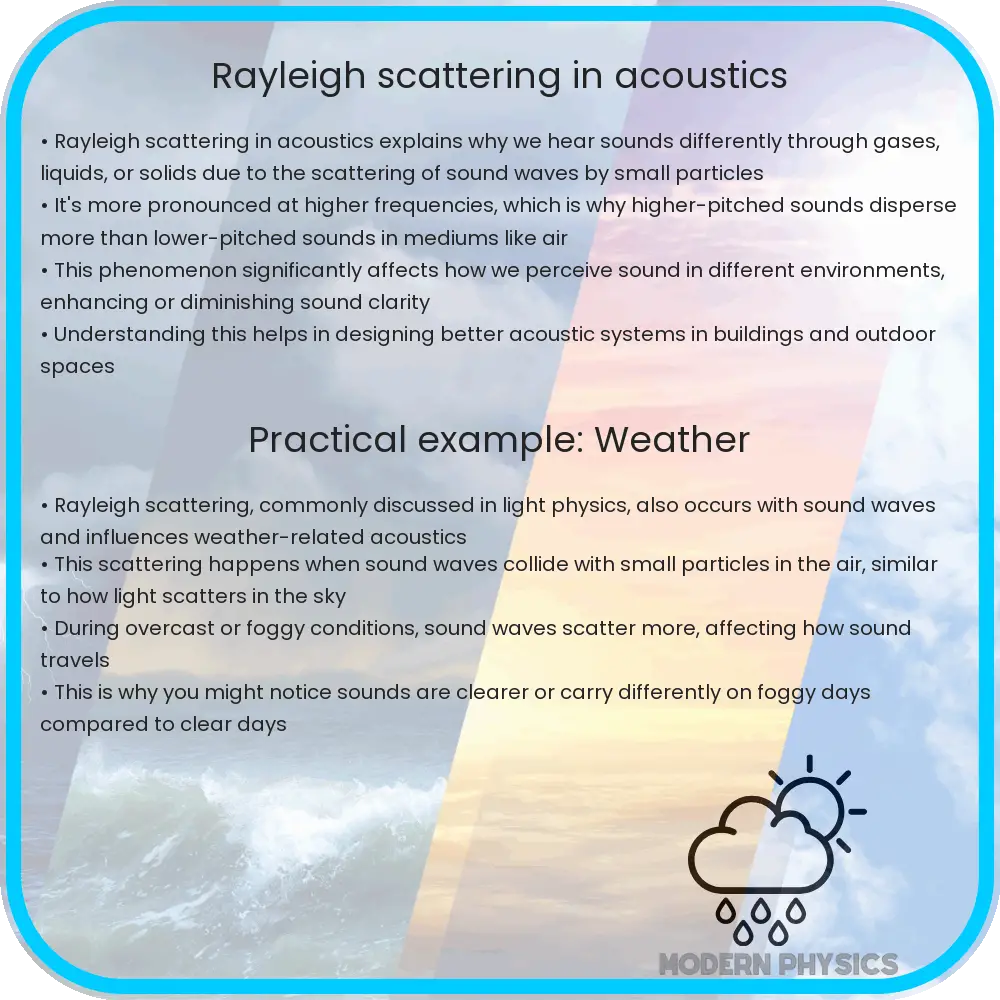Understanding the role of Rayleigh scattering in acoustics, a phenomenon where sound waves are dispersed by small particles, affecting sound propagation and clarity.

Understanding Rayleigh Scattering in Acoustics
Rayleigh scattering, a concept commonly associated with the blue color of the sky in optics, also plays a significant role in acoustics, particularly in the propagation and analysis of sound waves. This phenomenon can help us understand more about how sound behaves in different mediums, such as air or water.
What is Rayleigh Scattering?
Rayleigh scattering in acoustics refers to the scattering of sound waves by particles that are much smaller than the wavelength of the sound. Named after the British physicist Lord Rayleigh, this fundamental concept explains how sound waves are dispersed in all directions as they encounter small particles or fluctuations in the medium through which they are traveling.
Wave Physics: Sound Propagation
Sound waves are longitudinal waves consisting of compressions and rarefactions that travel through a medium. When these sound waves encounter small particles or irregularities within the medium, parts of the waves are scattered in various directions. This scattering affects the clarity of the sound, contributing to phenomena such as echoes or reverberation.
Quantitative Analysis of Rayleigh Scattering
The intensity of Rayleigh scattering can be quantified by its dependency on the size of the scattering particles and the wavelength of the sound. The intensity I of the scattered sound is inversely proportional to the fourth power of the wavelength (λ) of the sound, represented mathematically as:
I ∝ 1 / λ4
This relation indicates that shorter wavelengths are scattered much more than longer wavelengths. In acoustics, this means high-pitched sounds (shorter wavelength) are more likely to be scattered than lower-pitched sounds (longer wavelength).
Spectra and Sound Analysis
In practice, understanding Rayleigh scattering is crucial for analyzing the spectrum of sound in various environments. For example, underwater acoustics extensively use this principle to study sound propagation in oceanic research. By examining how different sound frequencies scatter, scientists can infer properties about the medium, such as temperature and salinity, or even detect objects under the water.
Real-world Applications
Rayleigh scattering is not only a theoretical model but also a practical tool in many engineering fields. Engineers designing concert halls, for example, use knowledge of sound scattering to optimize acoustics for clearer sound transmission. Similarly, in architectural acoustics, understanding how sound interacts with small particles can help in designing buildings that minimize unwanted echoes and noise.
Environmental scientists also use Rayleigh scattering principles to monitor air quality. The scattering of sound waves by small particles in the atmosphere can provide data about the concentration and type of aerosols present.
Impact on Audio Technology and Communications
Rayleigh scattering also influences the design and use of microphones and speakers in different environments. Audio equipment is often tailored to mitigate the effects of scattering to ensure clearer sound quality. This includes the strategic placement of microphones in areas where scattering is minimized and the design of speakers that can handle the effects of scattering at different frequencies.
Moreover, in telecommunication, understanding Rayleigh scattering can improve the clarity and reach of broadcast signals. It is especially significant in satellite communication systems, where signals must travel through various layers of the Earth’s atmosphere, encountering particles that can scatter and distort the signal.
Impact on Radar and Sonar Systems
In radar and sonar systems, Rayleigh scattering is important for the detection and imaging of objects. By analyzing how sound or radio waves scatter off different surfaces or particles, these systems can create detailed images and locate objects. This application is critical in fields such as navigation, weather forecasting, and military operations.
The ability to predict and analyze Rayleigh scattering allows for enhancements in the resolution and accuracy of these systems, making them more effective and reliable in various operational conditions.
Conclusion
Rayleigh scattering is a multifaceted phenomenon that plays a crucial role in our understanding and manipulation of sound in both natural and engineered environments. Its impact stretches across various fields, from environmental science to audio engineering and communications technology. By shedding light on how sound waves interact with particles, Rayleigh scattering not only helps us with practical applications but also enriches our theoretical knowledge of wave dynamics.
The principles of Rayleigh scattering, therefore often taken for granted, are integral to numerous technological advances and everyday applications. As technology progresses and demands for more sophisticated acoustical analysis and design increase, the role of Rayleigh scattering in future innovations and scientific explorations will undoubtedly continue to expand. This ongoing interface of science and technology underscores the fundamental importance of understanding physical phenomena not just in isolation but as part of a larger, interconnected system.
